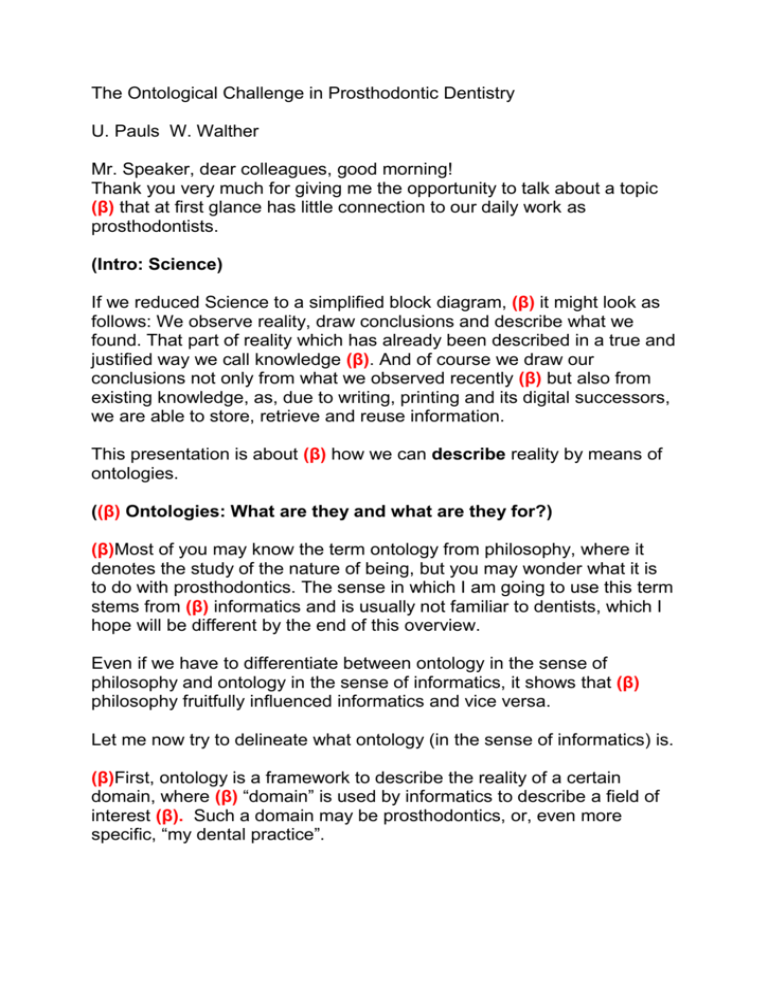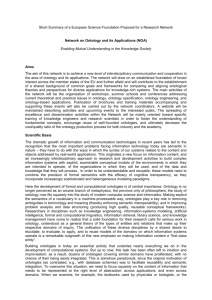The Ontological Challenge in Prosthodontic Dentistry
advertisement

The Ontological Challenge in Prosthodontic Dentistry U. Pauls W. Walther Mr. Speaker, dear colleagues, good morning! Thank you very much for giving me the opportunity to talk about a topic (β) that at first glance has little connection to our daily work as prosthodontists. (Intro: Science) If we reduced Science to a simplified block diagram, (β) it might look as follows: We observe reality, draw conclusions and describe what we found. That part of reality which has already been described in a true and justified way we call knowledge (β). And of course we draw our conclusions not only from what we observed recently (β) but also from existing knowledge, as, due to writing, printing and its digital successors, we are able to store, retrieve and reuse information. This presentation is about (β) how we can describe reality by means of ontologies. ((β) Ontologies: What are they and what are they for?) (β)Most of you may know the term ontology from philosophy, where it denotes the study of the nature of being, but you may wonder what it is to do with prosthodontics. The sense in which I am going to use this term stems from (β) informatics and is usually not familiar to dentists, which I hope will be different by the end of this overview. Even if we have to differentiate between ontology in the sense of philosophy and ontology in the sense of informatics, it shows that (β) philosophy fruitfully influenced informatics and vice versa. Let me now try to delineate what ontology (in the sense of informatics) is. (β)First, ontology is a framework to describe the reality of a certain domain, where (β) “domain” is used by informatics to describe a field of interest (β). Such a domain may be prosthodontics, or, even more specific, “my dental practice”. (β)Second, ontologies provides explicit and unambiguous specifications of the entities of interest and (that’s a point to stress) of their relations to each other. (β)All of you know relations e.g. from Taxonomies (β), where the subsumption relation is used. (β) But there are many other types of relations, (β) e.g. the part_of relation, which is used to describe mereological facts. By defining and adding different relations, we put (β) semantics into ontologies. (β)Third, ontologies have to be formalized in a way being readable by humans and computers. This is accomplished by using ontology languages like e.g. (β) the Web Ontology Language (OWL), which is a global standard provided (β) by the W3C organisation. Readability by humans is of course necessary because humans have to write and edit ontologies. But if you regard such an OWL-ontology like (β) this-one, and you find it unreadable, I would agree. (β) (β) Fortunately there are ontology-editors like e.g. Protégé which has been developed by Stanford University, (β) looking like this. Just to give you an impression how widespread ontology-work is nowadays, you should know that there are more than a 100.000 registered Protégé users wordwide. Readability by computers allows utilization and analysis of data that is structured on the basis of such ontologies. (β) Just a trivial example: If you extracted a crowned tooth (β), you would know that the crown is lost. Looking at your digital dental chart, you would expect something like (β) this and not a crown, (β) pending somehow between adjacent teeth like that one. This is achieved by accordingly (β) programming software graphics for every possible case. If the software was ontology-based, there would be some kind of dependency-relation between the crown and the tooth as its bearer. The program could thereby (β) infer that the crown is lost if the tooth was extracted, because of its semantically grounded model of reality. Providing more sophisticated software may be one reason to build ontologies, but there are others, which leads us to the second section. ((β) Ontologies: Why should we develop them and why should we use them.) First, I have to mention that researchers in the field of dentistry already use ontologies. (β) If I show you this list of papers, which are basicresearch publications (β) from periodontology and oral medicine, I don’t want you to read all this but just to notice that all of them refer to, in their abstracts, an ontology. (β)Taking a look at the locations in where these papers originate, (β) we find a global distribution. And all of them refer to (β) the Gene Ontology (GO). (β)The GO describes the effects of gene products on cells. The abundance of data resulting from biomedical research enforced a tool to describe explicitly that data. (β) The GO enables researchers to describe and compare their results, over the internet, globally. Actually, to improve storing, retrieving and reuse of information is the goal of any ontology. The success of the GO may be demonstrated (β) by this graph showing the number of publications concerning ontology in PubMed during the last ten years. If we realize the benefits of GO, why a (β) PO, a Prosthodontic Ontology should not provide similar (β) benefits, listed on the left, to the prosthodontic community? Today, incompatibility of data is a major problem in scientific informationexchange, (β) caused by different database structures but also by lacking semantic interoperability. (β) In literature, this is referred to as the silo problem, as data, (β) being enclosed in their different structures and semantics (β) similar as if being enclosed in different silos cannot communicate. (β)Imagine a multicenter study performed by some prosthodontic institutes e.g. to explore the survival rates of implants. For such a study, a special data structure would have to be created to raise the data. Since that established common structure was mostly not be compatible with each of the institute’s data management system’s structure, data would have to be entered twice, (β) and a lot of transforming and adapting effort would be necessary. If there was a prosthodontic ontology, established as a global standard, it could act as (β) interlingua, making data exchange on a global basis easier. If there was a prosthodontic ontology, established as a global standard, companies would, step by step, adapt the data structures of their practice- and clinical data management systems to that of the ontology. (β)This would help to broaden the basis for (β) EBD research as well as for case-based clinical decision support systems, which up to now have being suffered from too small data background. ((β)How to develop ontologies?) At this point, too, I have to mention that there are already dentists having developed or being developing ontologies. (β) I present to you these three papers: (β) Park Seon Gyu and co-workers from Seoul National University South Korea were perhaps the first to apply ontological principles within dentistry, developing an ontology of tooth-positions within the dental arc. (β)Miguel Torres-Urquidy and co-workers from the Center of Dental Informatics, University of Pittsburg, describe in their paper preliminary research concerning an ontology of dental diagnosis, which is still being developed. (β)Suzuki Asami and her co-workers from Tokyo Medical and Dental University developed an ontology describing pathogenic pathways in periodontology. These are indeed starting-points, however, if every research-group would develop ontologies independently, (β) we would create another silo-problem, wouldn’t we? This is the point, where philosophers and philosophically skilled ITscientists come into play, providing us with so-called (β) Top-LevelOntologies. These TLO’s describe (β) basic categories of reality and their relations, such as Continuant, Occurrent, Role, Disposition etc. (β) References between domain ontologies and Top-Level-Ontologies help to avoid the silo-problem by harmonizing them. (β)I would like to mention here Barry Smith from New York State University in Buffalo, (β) Nicola Guarino from the Laboratory of Applied Ontology in Trento, Italy and (β) Mizoguchi Riichiro from Osaka University, Japan, the acronyms of their Top Level Ontologies in parentheses. Referring to TLO’s, we can now design a system of ontology layers that are well coordinated with each other. (β) A Top-Domain-Ontology could be e.g. an ontology of dentistry, (β) the prosthodontic ontology would be a domain-ontology. Task-ontologies are small ontologies designed to support specific software solutions, (β) e.g a dental practice management system. (β)The process of developing ontologies is described as follows: (β) First, defining the boundaries of the domain, (β) second, collecting terms, (β) third, sorting and ordering them in respect of higher-ranking ontologies and by applying relations, (β) fourth, verifying by ontological analysis and fifth, (β) formalizing the ontology. (β) With regard to prosthodontics, even the first point would be a demanding task considering the vague boundaries between prosthodontics and restorative dentistry on the one hand and prosthodontics and implantology on the other hand. (β) Collecting terms should be easier, since a lot of effort has been made to establish terminologies, such as ICD, SNOMED or SNODENT. The question rising up at this point is why not to use these terminologies? The answer is that they, from an ontological point of view, have many shortcomings, which has been proven by several publications. In addition, they neither are, in particular in prosthodontics, detailed enough, nor are all of them free of fees. But even if it would be reasonable to develop ontologies from scratch, it would be of course a mistake not to include the pool of already collected terms. (β) The third step demands not only a thorough knowledge of the applied TLO, but also of the semantic content of the listed terms. Thus, in case of a Prosthodontic Ontology, it could only be done by prosthodontists. (β) Ontological analysis is a tricky business, but you don’t need to be a philosopher to engage in it, because ontologist-philosphers provide us with the necessary methods, like (β) e.g. the ONTOCLEAN method. (β)The formalization may be supported and checked by computer specialists. (β) Finally it should be mentioned that ontology development never ends, since ontologies have to be adapted to the progress of knowledge. All in all, the development of ontologies is a difficult job, that’s why I (β) called it a challenge. It must not be concealed that there are critical voices, too, concerning ontologies, which to delineate here would exceed time constraints. However, we should at least make an effort to explore the advantages ontologies may provide for prosthodontics as a science. (β) People, who are interested in developing a PO, of course have to be prosthodontists. We can not leave it to IT-scientists to do this task. As this job should be done on a global basis, the (β) ICP would be a suitable organisation to acquire interested people from its own ranks. Thank you very much for your attendance.







